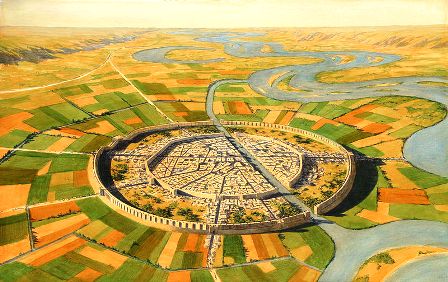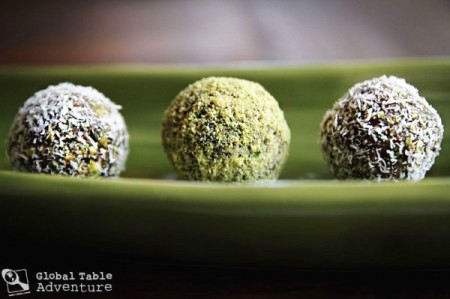The first entry in our Mesopotamian Cookoff comes from friend in the blogosphere, Sasha Martin over at Global Table Adventure. As fate would have it, she was cooking the food of Iraq the same week that I announced the Cookoff and instantly noted the connections between the Babylonian mersu recipe and a confection on the modern Iraqi table. Using only the dates and pistachio nuts in the original recipe, Sasha came up with the glorious treats pictured here. For some of the mersu, she added a coconut* topping as a variation that adds visual interest in the presentation and tastes delicious as well.
Mersu
As envisioned by Sasha, mersu combines the natural, unaltered and unenhanced flavors of the dates and pistachio nuts in delicious ways. The dates are ground, mixed with minced pistachio nuts and then rolled into bite-size confections. Delicious as is, Sasha took this an extra step and rolled the date-nut balls in ground pistachio nuts and ground coconut, and arranged them as pictured above.
Ingredients
1 cup pistachios
1 cup pitted dates
1/8-1/4 cup pistachios, ground for rolling and/or
1/8-1/4 cup shredded coconut for rolling (optional)
(Makes 12)
Directions
Blend dates into a paste by pulsing in a food processor. If you prefer the authentic, Mesopotamian preparation techniques, pound and rolling the dates will produce the same results – but take a lot longer and leave your arms sore unless you are accustomed to making bread.
Then add the minced pistachios and pulse or pound again until integrated and smooth.
Form into small balls. Sasha leveled the mixture in a tablespoon to make sure they all came out the same, then she rolled them in her hands. About half way through, she washed her hands and the spoon to reduce stickiness. This made a dozen.
As a finishing touch, roll the date balls in ground pistachios or shredded coconut. The pistachios coating is more traditional, although the coconut is fun. (Make ground pistachios by pulsing a 1/4 cup in a coffee grinder or food processor.) To see this recipe constructed step by step and to catch Sasha’s food and time travel vibe – click here.
______

In a reference I just pulled last night by Marcel Sigrist (JCS 29, 1977) on the creation of food offerings for celebrations at the Temple of Nusku (light/fire) in Nippur, the author cites tablets that suggest alternate (not additional) ingredients for mersu. Other ingredients that could be used in place of dates include figs and raisins and another unspecified type of date. Other ingredients that could be used in the place of the minced nuts in the body of the confection are minced apples. Other ingredients listed as potential reference include fat, cheese and wine. At first these may seem incongruous to the concept of mersu. But even considering only the mode described by Sasha, fat could be used to make a smoother pound fruit center, the cheese could be a hard variety, minced and used in the body of the dish or grated and used as a coating as the pistachios were used by Sasha. If a soft cheese were used, it could become a creamy center to the fruit body. Another variation could be a dried kashk-like substance to coat the dates.
The ingredient wine is very interesting. There is chemical evidence for wine inside jars that suggest that wine was probably already being enjoyed by at least the upper classes in Late Uruk times (ca. 3500-3100 BCE), but how would this translate into the mersu recipe? Well, wine could be used as liquid to moisten the dates just a bit, or the must or pomace from the making of the wine could be evaporated or dried and used as a container for ingredients that are folded or rolled inside it – like a modern “fruit roll-up” snack. It could also be dried and ground and used as a powdery coating. So there are many more potential variations to even Sasha’s confection to be had by switching out ingredients.
Ancient Mesopotamian food, as you can see, is a fabulous and varied cuisine tht is beginning to rise from the embers of history. I’m hoping others will create different mersu for us to enjoy over the course of the next couple of months. There are other ways to combine these ingredients – I’m sure of it – give it a try!
(Words by Laura Kelley, Recipe and Method for this form of Mersu by Sasha Martin. Photo of Mersu by Sasha Martin; Drawing of Mari by Balage Balogh from Wikimedia.)
*(Coconut might have been known by the neo-Assyrian period, but was probably not used at the time the original recipe was recorded.)

